Oct
30
2011
Valora’s Log – The Beginning
Author: DavidI had always built my own boats because by designing and building the boat I got exactly what I wanted. So the decision to buy a boat was a new one. Let me say this was a decision I didn’t arrive at easily. I had spent five years designing my perfect boat and that was not easy to leave behind.
I wanted a blue water boat, a boat that I could live aboard and would safely take me where I wanted to go. To build a boat of that size takes time, at least a year and realistically more like two years, perhaps longer.
If I found a boat I liked that building time could be time spent using the boat. This was an important part of the decision because my window of opportunity was starting to get smaller. Age was starting to close it.
Finding a boat I liked was the big question. There is a huge number of new and used boats on the market so selection wasn’t an issue. Finding a boat I liked in my budget might be.
I knew I didn’t want a fixer-upper. If I was going to go that route I would just build my design from scratch. That meant the selection got much smaller but I still had a large number of good boats that met my criteria. At least I hoped that was the case.
So that is how I started the process; a very definite idea of what I wanted, a fixed amount of money and very little experience and knowledge about the process.
Like any process there were many lessons. The small lessons were fortunately not expensive. Other lessons were not so inexpensive.
This is a chronicle of the process, the experience gained and those lessons.
LOVE’S ROAD TAKES AN UNEXPECTED TURN
I found what I thought was close to the perfect boat on the rebound. A deal on a Nimble 30 (what I thought was the perfect boat) had just fallen apart when my surveyor found some completely unexpected problems. Because the Nimble had been the perfect boat in my eyes, I looked at the ad for a Southern Cross 28 through glasses tinted with disappointment. The Southern Cross is a fine boat. It wasn’t the Nimble but I needed to move on. In retrospect, not a good way to approach any relationship but I was on the rebound.
A phone call was made to the owner and I decided that if the boat was as good as represented I would start the process to buy it. This was just a verbal description as there was only one poor quality photo of the boat online. Another phone call was made to let the owner know I was on my way to look at the boat and if it was as represented I would make an offer. I explained that I was reluctant to make an offer on a boat from one photo.
I should point out that the boat was not just down the road in the next town. It was on Lake Champlain in Vermont and I was pulling a large gooseneck trailer from Texas. I left Austin in mid April in shorts and a tee shirt. My friend Gene (the guy that owned the trailer) was sunburned from a weekend of sailing. Somewhere in Tennessee we changed into long pants and jackets and we were driving in snow by Pennsylvania. The snow continued all the way to Vermont.
The weather was a little unusual and unexpected but the real surprise was waiting for us in Vermont. The owner of the Southern Cross informed me that he had sold the boat while we were in route. I was stunned. He had my cell phone number but never bothered to call. What a nice guy.
I think I would have used some rather rude and vulgar language if I hadn’t had a plan B. Actually; I came very close to telling him exactly what a chicken shit, asshole he was but I’m glad I took the higher road.
Plan B was several boats in Maine that I was interested in. So we pulled the trailer across the White Mountains, which were white with snow, to Bangor Maine and started making arrangements to look at boats.
The boats proved to be a disappointment and by day three I was getting really depressed. I had just driven 2000 plus miles pulling a gooseneck trailer with diesel about four dollars a gallon. And it was seriously looking like I was going to pull that trailer another 2000 plus miles back home with nothing on it but some snow from Maine.
Then the road took another unexpected turn when Gene said, “Hey Dave look at this boat. This looks like something you’d build.”
Each night we had been scouring the brokerage sites looking for “the” boat and now perhaps all the scouring had paid off. The site had a large number of photos and we both agreed that if the boat was half what it looked like in the photos it was a find.
Interestingly the price had just been reduced the day before. The boat was now in my price range so I called a broker that is a friend of Gene’s and had him make an offer. The offer was accepted so we faxed contracts, sent checks, and got all the paper work in order. I didn’t want to have another Sothern Cross episode.
We packed our bags, filled up the truck, and started out. We were in Maine and the boat was in Clearwater, Florida.
There was a plus to this strange turn in the road; I would now be in Florida for my nephew’s wedding. I have to say that this made my incredibly understanding wife very happy and I was glad to be able to attend the wedding as well. Things were looking up a bit.
MEETING FOR THE FIRST TIME – SEA TRAILS AND OTHER PRELIMINARIES
Getting everyone’s social calendar and dance card to match up for the sea trails took a bit of time; several days of sitting in a Clearwater, Florida motel watching absolutely nothing on 147 channels of cable TV, actually. But when it all came together and I saw the boat for the first time I knew the drive had been worth it.
I think the best way to describe my reaction would be like meeting a dark haired, dark eyed, exotic beauty in a room full of blonde haired, blue eyed, ‘girls next door’, very different from everybody else in the room but truly striking.

I was feeling good when I stepped aboard but the more I looked the better I felt. The ad had described the boat as custom built but that can encompass a boat only a mother can love to a finely crafted, well thought out vessel. This was most definitely the latter. It didn’t take long to see that this was a beautifully executed, traditional wooden boat on a fiberglass hull.

|
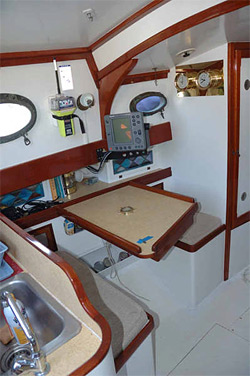
|
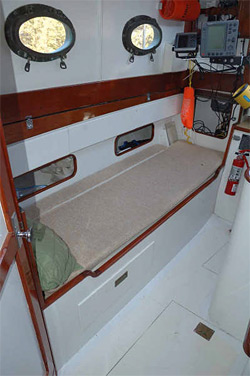
|
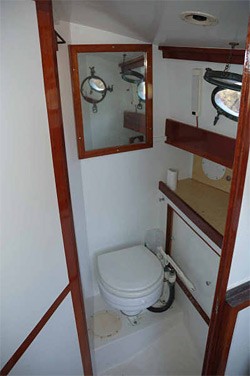
|
A boat can be beautiful but sail like a bath tub so I was very interested to see how well the boat performed. The hull was a modified Charles Morgan Tiger Cub. Because Morgan designs excellent boats I expected her to perform well but you never know.
It was a long motor from the slip to Clearwater Pass but it gave us a chance to see how well the engine ran. It was listed as a new 2009 Yanmar and it sounded like it was in very good shape. There was some engine vibration but nothing to kill the deal.
At the Clearwater bell buoy we shut down the engine and raised the sails. It was quickly clear that the boat had good manners. Her motion was easy in the sloppy chop generated by the 15 to 18 knots of wind. All points of sail were tried, we hove to, we lay ahull, and I was still happy. She did everything ask of her in a straight forward, solid way. It was obvious that when things got nasty the boat would take care of you and that was what I wanted. So it was time to move to the next step which meant I needed a good marine surveyor.


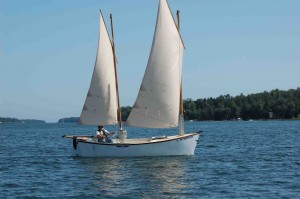
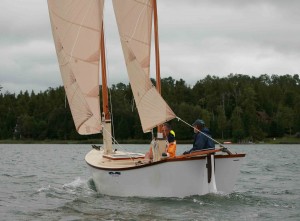

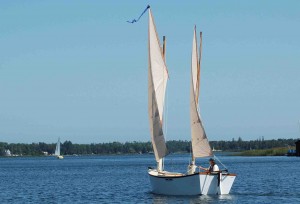

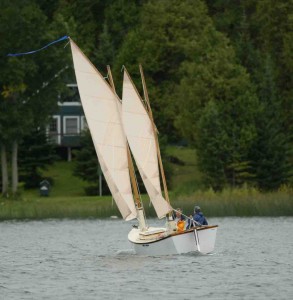

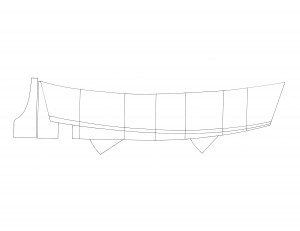

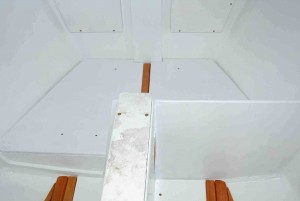
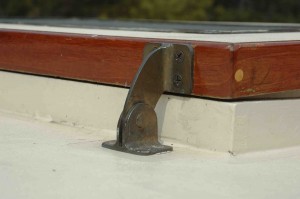
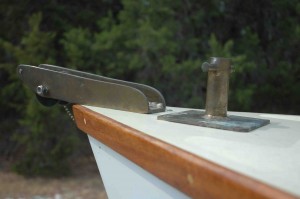
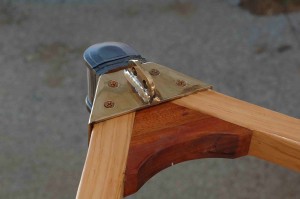


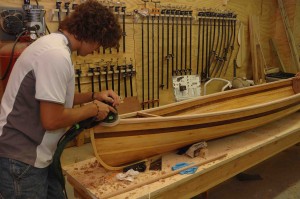
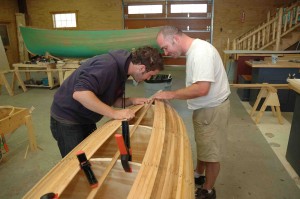
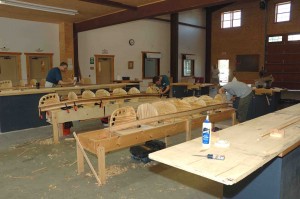

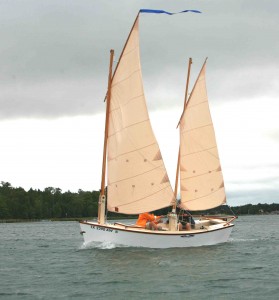
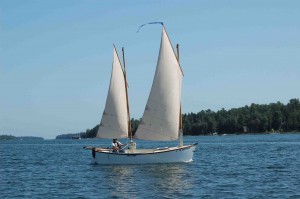 After launching in Lake Travis is Austin, TX PANDION was towed to Michigan’s Upper Peninsula and the Les Cheneaux Islands where she spent the summer while I taught at Great Lakes Boat Building School. I was able to sail her in a wide variety of wind conditions. The boat performed very well and proved herself to be Weatherly and sea kindly. The boat will sail through 100 degrees and makes no discernable leeway. Not bad for a boat that only draws 28 inches with the boards down. I found the boat tender to 10 degrees of heel and passed 10 degrees the boat stiffens up and in 15 to 20 MPH wind and no reefs I was not able to put the rail down. Light air performance seems to be good as well and the boat will ghost along in very light winds. It was a good summer sailing and a good summer teaching. Look for the book on building Pandion and her little sister in the Spring of 2010
After launching in Lake Travis is Austin, TX PANDION was towed to Michigan’s Upper Peninsula and the Les Cheneaux Islands where she spent the summer while I taught at Great Lakes Boat Building School. I was able to sail her in a wide variety of wind conditions. The boat performed very well and proved herself to be Weatherly and sea kindly. The boat will sail through 100 degrees and makes no discernable leeway. Not bad for a boat that only draws 28 inches with the boards down. I found the boat tender to 10 degrees of heel and passed 10 degrees the boat stiffens up and in 15 to 20 MPH wind and no reefs I was not able to put the rail down. Light air performance seems to be good as well and the boat will ghost along in very light winds. It was a good summer sailing and a good summer teaching. Look for the book on building Pandion and her little sister in the Spring of 2010